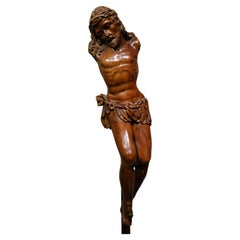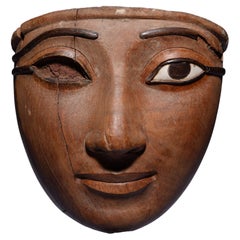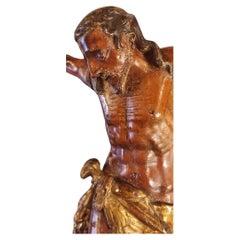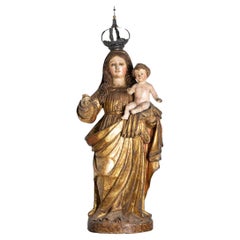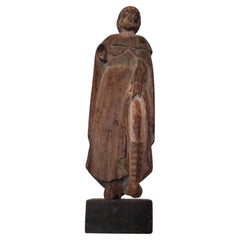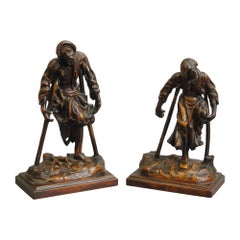Hardwood Figurative Sculptures
32
to
5
18
14
32
32
32
6
2
32
58
154
52
31
60
33
6
1
5
4
12
11
7
5
1
Height
to
Width
to
58,489
610
256
233
208
20
6
6
4
4
Period: 18th Century and Earlier
Material: Hardwood
Christ in Boxwood, France, late 16th-early 17th century".
Located in PARIS, FR
Christ in Boxwood, France, late 16th-early 17th century
Beautiful corpse of Christ with missing arms.
He must have been on the Cross, arms in a horizontal position.
Great expressiv...
Category
Early 17th Century French Renaissance Antique Hardwood Figurative Sculptures
Materials
Boxwood
Exceptional Egyptian Sarcophagus Mask
Located in London, GB
Exceptionally Fine Wooden Sarcophagus Mask
Third Intermediate Period, 21st Dynasty, circa 1069-945 BC.
Acacia wood, rosewood, hippopotamus ivory
Masterfully carved from a single piece of fine-grained hardwood, the present mask is characteristic of the most exquisite funerary art made during the 21st Dynasty, and was probably commissioned for a particularly high-ranking individual.
The oval face displays a gently smiling mouth with full, outlined lips, furrows at the corners and a bow-shaped philtrum. The straight nose with rounded nostrils, the cheeks full and fleshy and the large, almond shaped eyes with heavy lids and tapering cosmetic lines, set below long, sweeping eyebrows.
Social collapse across the Mediterranean in the Late Bronze Age meant that the 21st Dynasty in Egypt was a period of great turmoil. Trade routes were disrupted, governments collapsed, and mass migration occurred. Economic scarcity meant that traditional funerary practices in Egypt were also affected, with a lack of material and financial resources leading to the reuse of preexisting material. As a result, during the 21st Dynasty, 19th and 20th Dynasty coffins changed ownership rapidly and were heavily recycled for new purposes. Tombs were also unmarked allowing them to be shared
by many people. These new practices brought forth a shift in the understanding of funerary paraphernalia. No longer important objects owned forever by the deceased, they were now simply seen as short-term transformative devices, whose symbolic and ritualistic meaning could be appropriated for others. However, paradoxically, the art of coffin-making also reached new heights during this period, and many of the richly dec- orated “yellow” coffins, characteristic of the 21st Dynasty, are remarkable works of art in their own right. Indeed, knowing that coffins were being reused throughout Egypt, the Egyptian élite set themself apart by commissioning lavish sarcophagi decorated with the images and texts meant to help guide them to the afterlife, and which would otherwise have adorned the tomb walls. As coffins were the chief funerary element which now identified the dead and allowed them a physical presence in the world of the living, their quality and appearance were of the utmost importance.
The traditional coffin ensemble was made of three parts: a wooden mummy cover, which laid directly atop the mummy, an inner coffin, and an outer coffin, both made of a lid and case. Additional decorative elements, such as masks, were carved out separately and later glued or pegged to the lids. After the completion of the painted decoration, the sarcophagus was covered in a varnish to give it its yellow colour. Gilding was sometimes used for the coffins of the high priests’ families, notably on parts representing naked skin, such as the face mask. However, some of the élite tactically avoided gilding altogether as to ensure that their coffin would not be looted.
When manufacturing the inner and outer coffins, particular attention was paid to the woodwork. Displaying the skill of the carpenter, this type of funerary art has largely remained unparalleled throughout Egyptian history. The principal wood used to craft the present mask is Acacia nilotica. The evergreen Egyptian acacia was considered sacred and said to be the tree of life, the birthplace of the god Horus, as well as symbolic of Osiris, the god of the dead and resurrection. The modelling of the face in the wood is superb, but the inlays also help mark this mask out as exceptional. Inlaid eyes and eyebrows were extremely rare and reserved to the finest and most expensive coffins. Traditionally, eyes were made of calcite, obsidian, or quartz, and eyebrows of coloured glass paste or bronze. Here, the pupils, eyebrows, and cosmetic lines are inlaid with Dalbergia melanoxylon, a rare type of wood which belongs to the rosewood genus.
In antiquity, however, it was known as Ebony of the Pharaohs, from the Egyptian word “hbny”, meaning dark timber, because of its black, lustrous appearance. An extremely dense and hard wood requiring significant skill to work with, ebony was a luxury material highly coveted by the pharaohs themselves, to make furniture, decorative and funerary objects. The wood was imported with great effort from the southern Land of Punt, most likely modern Sudan, Ethiopia, Djibouti, and Eritrea, alongside other luxury goods such as gold and ivory.
A magnificent ebony throne, recovered in the tomb of King Tutankhamun, illustrates the incredible aesthetic potential of this material and why it was so highly valued by Egyptian royalty. Only élite members of Egyptian society could have afford- ed Ebony of the Pharaoh inlays for their funerary mask.
The sclerae on the present piece were once both inlaid with hippopotamus ivory. Whiter than elephant ivory, this type of ivory is also denser, and more difficult to carve. The use of this luxury material, reputed for its gleaming appearance, enhances the lifelikeness of the eyes. For the Egyptians, hippopotamus ivory was imbued with magic powers. The hippopotamus was indeed both feared and venerated due to its aggressive behaviour. Whilst the male hippopotamus was associated with danger and chaos, the female was benevolent and invoked for protection, especially of the house and
of mothers and their children, through the hippopotamus goddess Tawaret. Thus, not only was hippopotamus ivory used as an inlay and to make practical objects, such as combs and clappers, but it was also used to make talismans like apotropaic wands or knives.
Made during a time of scarcity where few could afford made-to-order coffins, the present mask could have only belonged to one of the highest-ranking individuals in society. Undoubtedly one of the finest Egyptian coffin...
Category
15th Century and Earlier Egyptian Egyptian Antique Hardwood Figurative Sculptures
Materials
Fruitwood, Hardwood
Christ Crucified in boxwood and golden loincloth
Located in Salò, IT
Christ Crucified in boxwood and gilded loincloth, 16th-century German sculptor, height from head to foot 31 cm, width between hands 30 cm.
Christ also has golden highlights on the pr...
Category
16th Century German Antique Hardwood Figurative Sculptures
Materials
Boxwood
17th Century Baroque Figure Of «Madonna and Jesus», Portugal
Located in Lisbon, PT
A late 17th-century figure in polychromed chestnut wood with excellent carving and gilding, dressed in a flowing veil and cashew hair down the shoulders. The cheekbones and nose are ...
Category
Late 17th Century Portuguese Baroque Antique Hardwood Figurative Sculptures
Materials
Gold Leaf
17th Century Spanish Colonial Hispano-Philippine Carved Santo
Located in Forney, TX
A scarce 17th century Spanish Colonial carved wood santo with provenance from the National Museum of the Philippines Manila.
circa late 1600s
A large part of what makes this example so very rare is not just the age and condition, but the saint depicted, San Roque.
The Hispano-Philippine (Spanish-Filipinos) hand carved hard wood religious altar figure presents splendidly, with scattered remnants of original gesso and polychrome pigments, the exceptionally sculpted religious folk art depicting San Roque (Saint Roch or Rocco), the 14th century Catholic patron saint frequently invoked against the plaque, various infectious disease, as well as patron saint of dogs, invalids, of falsely accused people, and of bachelors, amongst others.
Provenance / Acquisition:
Retaining registration - identification label to verso from The Republic of the Philippines (RP) National Museum of the Philippines Manila with hand written registration number.
Acquired from highly reputable auction house, Austin Auction Gallery, est. 1982, Austin, Texas. February 2022 catalog.
Dimensions: (approx)
Overall: 15.75" High, 5" Wide, 4" Deep.
Figure: 14" High
1.5lbs
Great original antique condition, especially considering it's around 350 years old. Nicely aged patina over the whole. Presented on a later wood plinth base. Typical loss to right arm, minor finish losses, old tiny metal plate added to prevent age related splitting, all wear consistent with age, and only adds to the overall sophisticated character, authenticity, and charming rustic warmth that can only be acquired over long periods of time.
We here at Lynx Hollow Antiques absolutely love religious antiques, from an antique altar, church architectural salvaged building and ornamental elements, reliquary, tabernacle cabinet...
Category
17th Century Spanish Colonial Antique Hardwood Figurative Sculptures
Materials
Gesso, Hardwood
A PAIR OF FINELY CARVED BOX WOOD Figures Of Beggars
Located in Lincolnshire, GB
A pair of 18th century German figures of one legged beggars after the engravings of Rembrandt in box wood.
Circa 1780
Category
Late 18th Century German Antique Hardwood Figurative Sculptures
Materials
Boxwood
18th Century Wooden Sculpture of the Virgin Mary
Located in Madrid, ES
This exceptional sculpture, finely carved from solid wood and dating back to the 18th century, pays tribute to the devotion and artistic skill of its era. Depicting the Virgin Mary, ...
Category
1740s Antique Hardwood Figurative Sculptures
Materials
Fruitwood
Seated Virgin with Child (Sedes Sapientiae) from the 12th Century in Spain
Located in Madrid, ES
Technique: Tempera and oil on wood
Dimensions: 25 x 11 x 8 cm
Description:
This exceptional work from the 12th century represents the Seated Virgin with Child (Sedes Sapientiae), standing out as an artistic treasure from medieval Spain. The portrayal of the Virgin enthroned with the Child on her lap is emblematic of Romanesque art, and this particular piece is a valuable and authentic example of that era.
The current polychromy belongs to the Gothic period and overlays the original Romanesque layer. It is crucial to highlight that the current state of the artwork is the original, without any cleaning interventions, imparting a unique authenticity.
The work exhibits architectural characteristics typical of Romanesque art, evident in the sides of the throne. The rigidity and symmetry characteristic of this style are reflected in the firm presentation of the Baby Jesus, noticeable in his gesture while holding his son. The Virgin wears a crown, symbolizing her royal character as the Queen of Heaven and Creation. Both figures retain traces of polychromy on the face and attire, adding layers of history and authenticity.
While similar Romanesque Virgin...
Category
15th Century and Earlier Antique Hardwood Figurative Sculptures
Materials
Fruitwood
18th Century French or Italian Santo Nativity Figure
Located in Nantucket, MA
18th century French or Italian Santo Nativity Figure, a hand carved and painted fruitwood figure for a Christmas Crèche or Krippe. Excellent and delicate details to the head and hands. The half figure stands on a dowel set into platform base, dressed in original fine linen robe...
Category
18th Century Italian Folk Art Antique Hardwood Figurative Sculptures
Materials
Linen, Fruitwood
18th Century Hand-Carved Jichi Wood Guanyin Figure
Located in New York, NY
This beautiful sculpture realized in China in the 18th century depicts Guanyin, a Bodhisattva associated with compassion. The female form holds a pot in her hands. She appears draped...
Category
18th Century Chinese Qing Antique Hardwood Figurative Sculptures
Materials
Hardwood
18th Century Italian Carved Wood and Polychromed Figure of Baby Jesus
Located in Ballard, CA
18th century exceptional Italian carved wood and polychromed figure depicting baby Jesus holding the world in his hand, he has halo made from sterling silver and the globe is also st...
Category
Mid-18th Century Italian Baroque Antique Hardwood Figurative Sculptures
Materials
Silver
Monumental 17th Century Angel
Located in Madrid, ES
Majestuous 17th century Angel.
Important carved, gilded and polychrome wooden angel from the 17th century from the choir of a church in Spain. It is of very good quality (see the dr...
Category
Late 17th Century Antique Hardwood Figurative Sculptures
Materials
Fruitwood
16th C Mechelen Doll-letter M carved in the back.Some leftovers of polychromy
Located in Leuven , BE
Mechelen dolls are rare wooden devotional figurines (mainly walnut was used), which were made by some members of the Guild of Saint Luke. The figures, all individual saints, were made from reference models using highly regulated carving and polychrome techniques. They had to meet several requirements. The shape of the rug had to meet certain criteria and the letter M (from Mechelen) had to be visible in the shape. These devotional or saint figurines...
Category
16th Century Belgian Antique Hardwood Figurative Sculptures
Materials
Fruitwood
Antique Large Figur "John the Baptist"
Located in Kastrup, DK
A wood carved baroque figure depicting John the Baptist (also called Johannes the Baptist) with original polychrome paint. Height: 152 cm.
Originates...
Category
18th Century Philippine Baroque Antique Hardwood Figurative Sculptures
Materials
Hardwood
A large wood Buddha/Guanyin with traces of pigments Ming Dynasty (1368-1644)
By Master
Located in Vienna, AT
A LARGE WOOD FIGURE OF GUANYIN WITH TRACES OF PIGMENTS
MING DYNASTY (1368-1644)
The bodhisattva is shown seated in padmasana, wearing long flowing ro...
Category
Mid-17th Century Chinese Ming Antique Hardwood Figurative Sculptures
Materials
Hardwood
Framed Collection of Mesoamerican Pre-Classic Period Sculptures & Arrow Heads
Located in New York, NY
Incredible collection of pre-columbian clay sculptures / figures / statues / pottery, mounted and framed. The pieces date from the pre-classic (Formative) period of Meso-American cul...
Category
15th Century and Earlier North American Pre-Columbian Antique Hardwood Figurative Sculptures
Materials
Clay, Precious Stone, Hardwood
17th Century Spanish Boxwood Christ on the Cross
Located in Marbella, ES
17th century Spanish boxwood Christ on the cross.
Category
17th Century Spanish Renaissance Antique Hardwood Figurative Sculptures
Materials
Boxwood
Boxwood Seal, Italy, XVIII Century
Located in Milan, IT
A XVIII century Grand Tour carved boxwood seal depicting Hercules with a square iron matrix. Italy 1750 ca.
Category
Early 18th Century Italian Antique Hardwood Figurative Sculptures
Materials
Iron
17th Century Cricifix Boxwood
Located in Milan, IT
17th century
Crucifix
Measures: Boxwood, 42 cm high x 8 x 14
The sculpture depicting the crucified Christ examined here represents a refined example of seventeenth-century cabinetry in boxwood. The figure of Christ, now dead on the cross, is part of a precious artistic choreography with the structure of the cross and its pedestal, both decorated with tortoiseshell mirrors, ivory threads to emphasize the structure of the cross and elements in ebonized and carved wood to highlight the architectural structure of the pedestal.
The departure of Christ is evident from the lowered head, from the open hands...
Category
17th Century Italian Antique Hardwood Figurative Sculptures
Materials
Boxwood
Pair of French 17th Century Angel Candle Holders in Carved Elmwood
Located in Dallas, TX
Standing at over two feet tall, this 17th century pair of angel candlesticks has been carved out of a beautiful French elm wood. Because elm wood typically has an interlocked grain, it can be quite difficult to carve or split. These candlesticks were produced by a master craftsman in France during the 1600s.
Our angels have long, wavy hair that extends past their shoulders. They are wearing long flowing gowns with scalloped collars and half sleeves. The loosely draped robe reaches their ankles, exposing bare feet that stand upon a round base. One leg is also visible from behind the material due to a slit at mid-thigh. Each angel is holding a turned candle holder that has a large wrought iron pricket with a lobed bobeche.
In France, this type of candle holder is known as an Ange Céroféraire. A ceroferary is the acolyte...
Category
17th Century French Antique Hardwood Figurative Sculptures
Materials
Metal
Ancient Boxwood Micro Carving Deposition, First Half of the 18th Century
Located in Milano, IT
Boxwood micro carving
Deposition
Central Europe, first half of the 18th century
It measures: the sculpture 7.40 x 5.31 x 0.6 in (18.8 x 13.5 x 1.6 cm); w...
Category
1740s European Baroque Antique Hardwood Figurative Sculptures
Materials
Boxwood
Pair 18th Century Hand-Carved Wooden Angels
Located in Dallas, TX
Pair 18th century hand-carved wooden angels were sculpted by a talented artist from solid blocks of hardwood, and feature exquisite features and d...
Category
Late 18th Century French Romantic Antique Hardwood Figurative Sculptures
Materials
Hardwood
18th Century French or Italian Santo Nativity Figure
Located in Nantucket, MA
18th century French or Italian Santo Nativity figure, a hand carved and painted fruitwood figure for a Christmas Creche or Krippe. Excellent and delicate details to the head and hands. The half figure stands on a dowel set into platform base, dressed in original fine linen robe...
Category
18th Century Italian Folk Art Antique Hardwood Figurative Sculptures
Materials
Linen, Fruitwood
French Mid-16th Century Body Of Christ
Located in Atlanta, GA
An outstanding French mid-16th century Body of Christ. Expertly carved from natural fruitwood. Stunning patina. The corpus has been attached to a base i...
Category
16th Century French Antique Hardwood Figurative Sculptures
Materials
Fruitwood
St. John the Baptist, Polychromed Boxwood, Baroque, 17th Century
Located in Madrid, ES
Stylistically, and to appreciate the stylistic differences, compare with the San Juan Bautista of the "Altarpiece of San Juan Bautista" by Juan de Juni and Inocencio Berruguete, dated in 1551 and today in the National Museum of Sculpture of Valladolid, or with the Sanint John the Baptist by Alonso...
Category
17th Century European Baroque Antique Hardwood Figurative Sculptures
Materials
Boxwood
17th Century Spanish Baroque Chestnut Carving of Christ
Located in Stamford, CT
A large-scale 17th century Spanish carving of Christ on the cross. Possibly of a much earlier date, the features and posture owing much to Byzantine depictions of Christ, especially ...
Category
17th Century Spanish Baroque Antique Hardwood Figurative Sculptures
Materials
Chestnut
17th Century Flemish Carving of a Religious Figure
Located in Rochester, NY
Antique carving of a saint or martyr. 17th century Flemish hardwood carving. Wonderful wear and rich color.
Category
17th Century European Antique Hardwood Figurative Sculptures
Materials
Hardwood
Altarpiece Representing The Annunciation, North of Portugal, circa 1600
Located in Brussels, Brussels
Exceptional altarpiece representing the annunciation circa 1600, fruitwood
rare altarpiece from the North of Portugal, unique due to its large size representing the scene of the annunciation, where the Archangel Gabriel (represented on the bottom left), sent by god (represented on the top left) announces to Marie (bottom right) that she will give birth to Jesus.
Very good state of conservation, carved on three panels
Dimension: Height 1m51
Width 1m03
Very nice colour and exceptional dimensions
Restorations of use
We placed the altarpiece on a red velvet base and a Spanish occasional...
Category
17th Century Portuguese Renaissance Antique Hardwood Figurative Sculptures
Materials
Fruitwood
Small Song Dynasty Carved Wood Bodhisattva, 13th Century, China
Located in Austin, TX
A small and very fine Chinese carved sandalwood figure of a bodhisattva, possibly Avalokiteshvara (Guan Yin), Song Dynasty (960 to 1276), circa 13th ...
Category
15th Century and Earlier Chinese Antique Hardwood Figurative Sculptures
Materials
Hardwood
Shan Burmese Lacquered and Gilt Wood Buddha, Ava Period, 18th Century
Located in Austin, TX
A rare and exquisite 18th century Ava period Shan Burmese figure of the Buddha.
Carved from a single block of wood, lacquered and gilt, the immensely s...
Category
Mid-18th Century Burmese Antique Hardwood Figurative Sculptures
Materials
Teak
Silvered Baroque Large Pair Friezes with Mirrors - Wall Sconces or Sculptures
Located in Alessandria, Piemonte
O/6818 - Large, important and beautiful pair of Italian old friezes, that completely decorate a wall, more than a picture, but like two sculptures. They may be used also like scon...
Category
Mid-18th Century Italian Baroque Revival Antique Hardwood Figurative Sculptures
Materials
Fruitwood
Chinese Carved Boxwood Figure of Guanyin, Mid-Qing Dynasty
Located in Austin, TX
A sublime Chinese carved boxwood figure of the Bodhisattva of Compassion, Avalokiteshvara, called Guanyin in Chinese, mid-Qing dynasty.
The an...
Category
Late 18th Century Chinese Qing Antique Hardwood Figurative Sculptures
Materials
Boxwood
Recently Viewed
View AllMore Ways To Browse
Carved Stone Figure Head
Antique Italian Swords
Emperor Napoleon I
Fruit Sculpture Pair
Italian Renaissance Pedestals
French Mannequin Head
Ormolu And Bronze Statue
Bronze Zeus
Wood Statue Saint
Colorful Statue
Nude Bronze Relief
Life Sizes Carved Figures
Collection Porcelain Figurines
Antique Bronze Statue Woman
Antique Roof Tile
Antique Roof Tiles
Sandstone Head
The God Hermes
